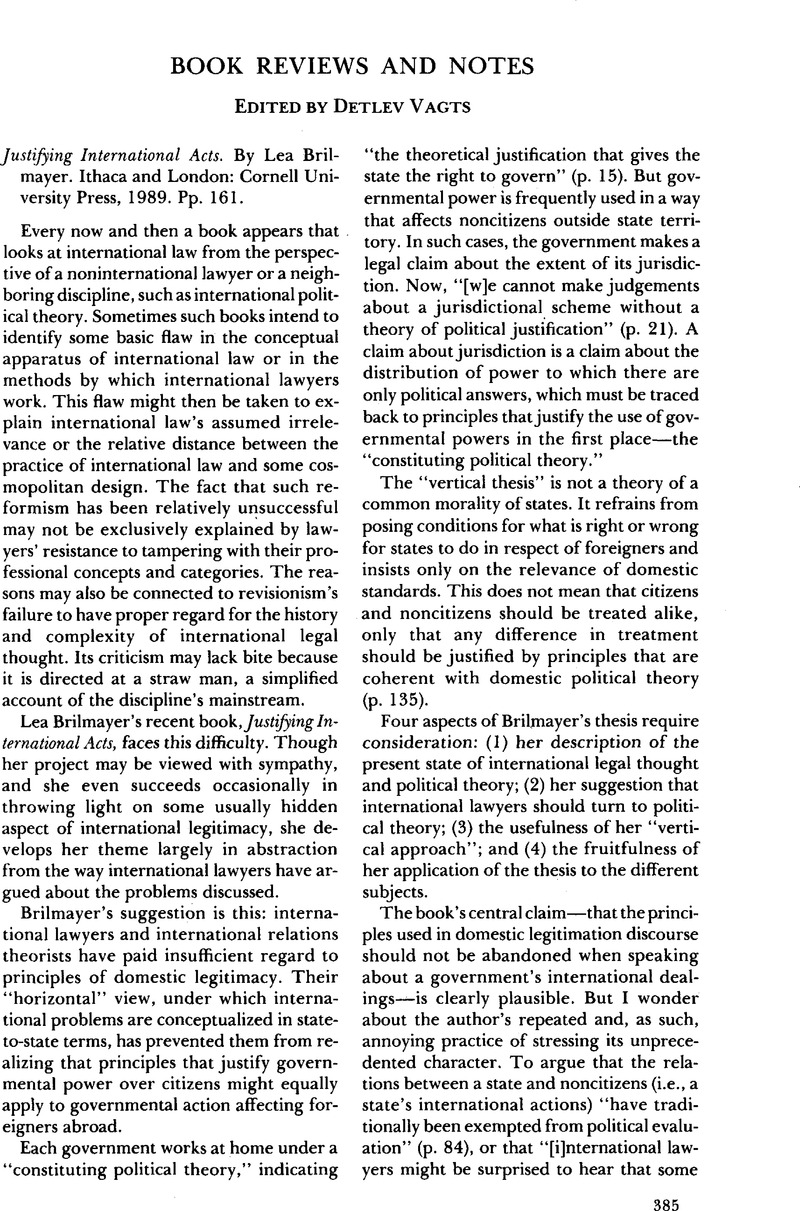No CrossRef data available.
Article contents
Justifying International Acts. By Lea Brilmayer. Ithaca and London: Cornell University Press, 1989. Pp. 161.
Published online by Cambridge University Press: 27 February 2017
Abstract

- Type
- Book Reviews and Notes
- Information
- Copyright
- Copyright © American Society of International Law 1991
References
1 See, e.g., J. Rawls, A Theory of Justice 378–79(1973).
2 See, e.g., J. Bentham, Principles of International Law, in 2 The Works 537 (J. Bowring ed. 1843); Kant, Zum ewigen Frieden, in Dokumente der Menschlichkeit (1919).
3 See generally E. B. F. Mldgley, The Natural Law Tradition and the Theory of International Relations (1975); Kennedy, Primitive Legal Scholarship, 27 Harv. Int’l L J. 1 (1986).
4 D. Hume, A Treatise on Human Nature 619 (E. C. Mossner ed. 1987) (1739).
5 Kant, supra note 2, at 28.
6 H. Suganami, The Domestic Analogy and World Order Proposals (1989).
7 The footnote after the classification makes reference to works by such political theorists as Joseph Nye, Charles Beitz and Hedley Bull. As “realists,” she names Kennan and Morgenthau (p. 33), while “State moralists” seem to include only Michael Walzer and Terry Nardin (pp. 34–35). Georg Schwarzenberger is the only European lawyer identified in the book—and this is done by reference to an old—1969—edition of his well-known Manual.
8 For example, there is no mention of what are probably the most important recent pieces in the literature on intervention: R.J. Vincent, Intervention and the International Order (1974); Intervention in World Politics (H. Bulled. 1984).
9 See, e.g., Roberts, Prolonged Military Occupation: The Israeli-Occupied Territories Since 1967, 84 AJIL 44, 61–66(1990).
10 This matter, however, may be somewhat corrected by the future judgment of the International Court of Justice in the Aerial Incident of 3 July 1988 case. See ICJ Communiqué No. 89/6, May 17, 1989.
11 G. Schwarzenberger, The Inductive Approach to International Law 40 (1965).
12 See, e.g., M. Koskenniemi, From Apology to Utopia: The Structure of International Legal Argument 65–66 (1989).
13 Waldock, The Control of the Use of Force by States in International Law, 81 Recueil des Cours 467 (1952 II).
14 For a brief introduction, see I. Brownlie, System of the Law of Nations: State Responsibility: Part I, at 132–79 (attributability), 199–240 (damage) (1983).
15 1935 PCIJ (ser. A/B) No. 64, at 19.
16 See, e.g., Colliard, Spécificité des Etats, théorie des statuts juridiques particuliers el d’inégalité compensatrice, in Le Droit International: Unité et diversite, Melanges offerts à Paul Reuter 153 (1981). See also Arts. 191(1) and 207(4), 1982 UN Convention on the Law of the Sea.




